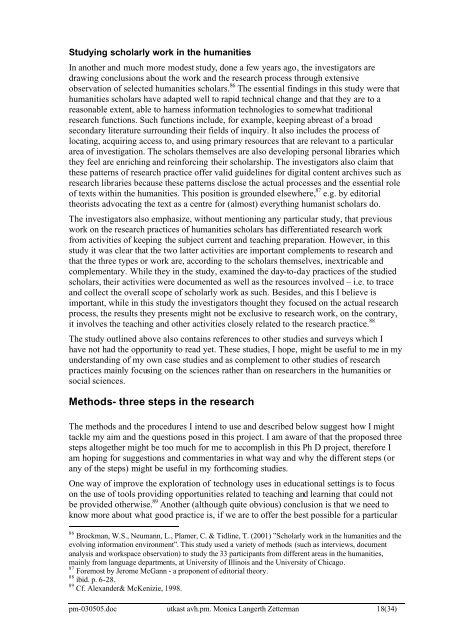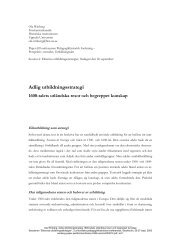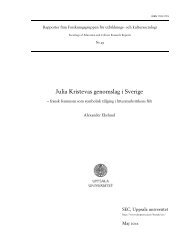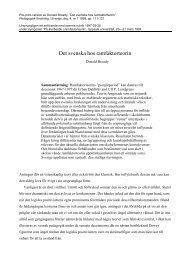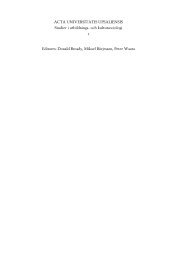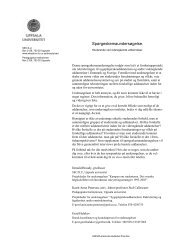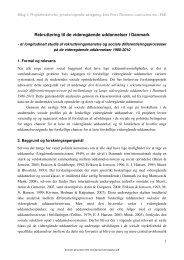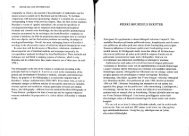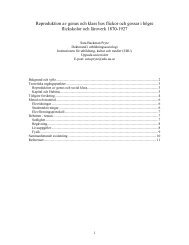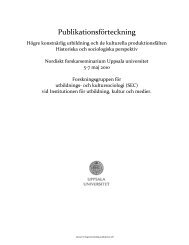exploring uses of digital archives in research and ... - skeptron.uu.se
exploring uses of digital archives in research and ... - skeptron.uu.se
exploring uses of digital archives in research and ... - skeptron.uu.se
Create successful ePaper yourself
Turn your PDF publications into a flip-book with our unique Google optimized e-Paper software.
Study<strong>in</strong>g scholarly work <strong>in</strong> the humanitiesIn another <strong>and</strong> much more modest study, done a few years ago, the <strong>in</strong>vestigators aredraw<strong>in</strong>g conclusions about the work <strong>and</strong> the <strong>re<strong>se</strong>arch</strong> process through extensiveob<strong>se</strong>rvation <strong>of</strong> <strong>se</strong>lected humanities scholars. 86 The es<strong>se</strong>ntial f<strong>in</strong>d<strong>in</strong>gs <strong>in</strong> this study were thathumanities scholars have adapted well to rapid technical change <strong>and</strong> that they are to areasonable extent, able to harness <strong>in</strong>formation technologies to somewhat traditional<strong>re<strong>se</strong>arch</strong> functions. Such functions <strong>in</strong>clude, for example, keep<strong>in</strong>g abreast <strong>of</strong> a broad<strong>se</strong>condary literature surround<strong>in</strong>g their fields <strong>of</strong> <strong>in</strong>quiry. It also <strong>in</strong>cludes the process <strong>of</strong>locat<strong>in</strong>g, acquir<strong>in</strong>g access to, <strong>and</strong> us<strong>in</strong>g primary resources that are relevant to a particulararea <strong>of</strong> <strong>in</strong>vestigation. The scholars them<strong>se</strong>lves are also develop<strong>in</strong>g personal libraries whichthey feel are enrich<strong>in</strong>g <strong>and</strong> re<strong>in</strong>forc<strong>in</strong>g their scholarship. The <strong>in</strong>vestigators also claim thatthe<strong>se</strong> patterns <strong>of</strong> <strong>re<strong>se</strong>arch</strong> practice <strong>of</strong>fer valid guidel<strong>in</strong>es for <strong>digital</strong> content <strong>archives</strong> such as<strong>re<strong>se</strong>arch</strong> libraries becau<strong>se</strong> the<strong>se</strong> patterns disclo<strong>se</strong> the actual proces<strong>se</strong>s <strong>and</strong> the es<strong>se</strong>ntial role<strong>of</strong> texts with<strong>in</strong> the humanities. This position is grounded el<strong>se</strong>where, 87 e.g. by editorialtheorists advocat<strong>in</strong>g the text as a centre for (almost) everyth<strong>in</strong>g humanist scholars do.The <strong>in</strong>vestigators also emphasize, without mention<strong>in</strong>g any particular study, that previouswork on the <strong>re<strong>se</strong>arch</strong> practices <strong>of</strong> humanities scholars has differentiated <strong>re<strong>se</strong>arch</strong> workfrom activities <strong>of</strong> keep<strong>in</strong>g the subject current <strong>and</strong> teach<strong>in</strong>g preparation. However, <strong>in</strong> thisstudy it was clear that the two latter activities are important complements to <strong>re<strong>se</strong>arch</strong> <strong>and</strong>that the three types or work are, accord<strong>in</strong>g to the scholars them<strong>se</strong>lves, <strong>in</strong>extricable <strong>and</strong>complementary. While they <strong>in</strong> the study, exam<strong>in</strong>ed the day-to-day practices <strong>of</strong> the studiedscholars, their activities were documented as well as the resources <strong>in</strong>volved – i.e. to trace<strong>and</strong> collect the overall scope <strong>of</strong> scholarly work as such. Besides, <strong>and</strong> this I believe isimportant, while <strong>in</strong> this study the <strong>in</strong>vestigators thought they focu<strong>se</strong>d on the actual <strong>re<strong>se</strong>arch</strong>process, the results they pre<strong>se</strong>nts might not be exclusive to <strong>re<strong>se</strong>arch</strong> work, on the contrary,it <strong>in</strong>volves the teach<strong>in</strong>g <strong>and</strong> other activities clo<strong>se</strong>ly related to the <strong>re<strong>se</strong>arch</strong> practice. 88The study outl<strong>in</strong>ed above also conta<strong>in</strong>s references to other studies <strong>and</strong> surveys which Ihave not had the opportunity to read yet. The<strong>se</strong> studies, I hope, might be u<strong>se</strong>ful to me <strong>in</strong> myunderst<strong>and</strong><strong>in</strong>g <strong>of</strong> my own ca<strong>se</strong> studies <strong>and</strong> as complement to other studies <strong>of</strong> <strong>re<strong>se</strong>arch</strong>practices ma<strong>in</strong>ly focus<strong>in</strong>g on the sciences rather than on <strong>re<strong>se</strong>arch</strong>ers <strong>in</strong> the humanities orsocial sciences.Methods- three steps <strong>in</strong> the <strong>re<strong>se</strong>arch</strong>The methods <strong>and</strong> the procedures I <strong>in</strong>tend to u<strong>se</strong> <strong>and</strong> described below suggest how I mighttackle my aim <strong>and</strong> the questions po<strong>se</strong>d <strong>in</strong> this project. I am aware <strong>of</strong> that the propo<strong>se</strong>d threesteps altogether might be too much for me to accomplish <strong>in</strong> this Ph D project, therefore Iam hop<strong>in</strong>g for suggestions <strong>and</strong> commentaries <strong>in</strong> what way <strong>and</strong> why the different steps (orany <strong>of</strong> the steps) might be u<strong>se</strong>ful <strong>in</strong> my forthcom<strong>in</strong>g studies.One way <strong>of</strong> improve the exploration <strong>of</strong> technology <strong>u<strong>se</strong>s</strong> <strong>in</strong> educational <strong>se</strong>tt<strong>in</strong>gs is to focuson the u<strong>se</strong> <strong>of</strong> tools provid<strong>in</strong>g opportunities related to teach<strong>in</strong>g <strong>and</strong> learn<strong>in</strong>g that could notbe provided otherwi<strong>se</strong>. 89 Another (although quite obvious) conclusion is that we need toknow more about what good practice is, if we are to <strong>of</strong>fer the best possible for a particular86 Brockman, W.S., Neumann, L., Plamer, C. & Tidl<strong>in</strong>e, T. (2001) ”Scholarly work <strong>in</strong> the humanities <strong>and</strong> theevolv<strong>in</strong>g <strong>in</strong>formation environment”. This study u<strong>se</strong>d a variety <strong>of</strong> methods (such as <strong>in</strong>terviews, documentanalysis <strong>and</strong> workspace ob<strong>se</strong>rvation) to study the 33 participants from different areas <strong>in</strong> the humanities,ma<strong>in</strong>ly from language departments, at University <strong>of</strong> Ill<strong>in</strong>ois <strong>and</strong> the University <strong>of</strong> Chicago.87 Foremost by Jerome McGann - a proponent <strong>of</strong> editorial theory.88 ibid. p. 6-28.89 Cf. Alex<strong>and</strong>er& McKenizie, 1998.pm-030505.doc utkast avh.pm. Monica Langerth Zetterman 18(34)


